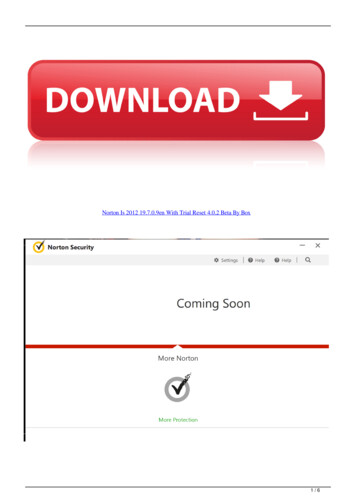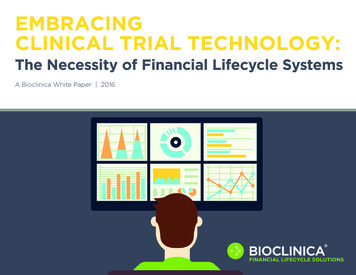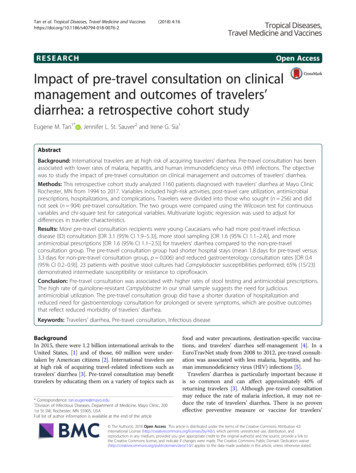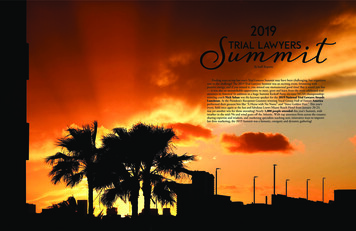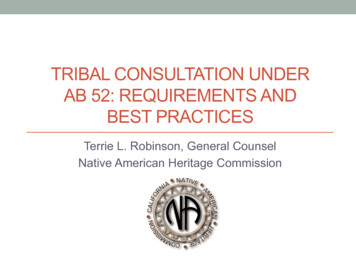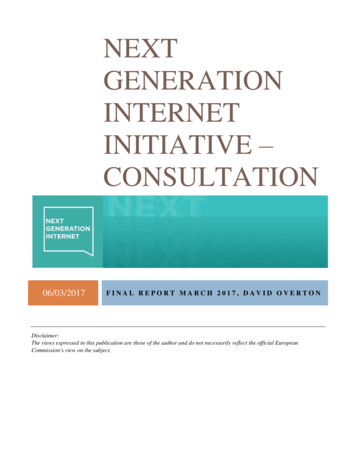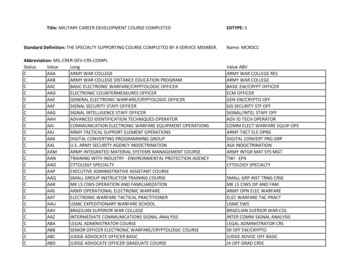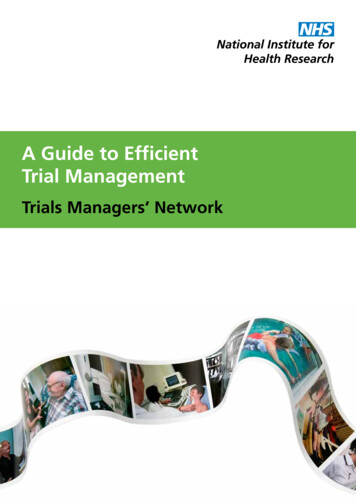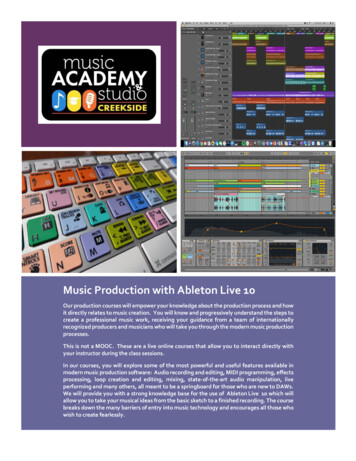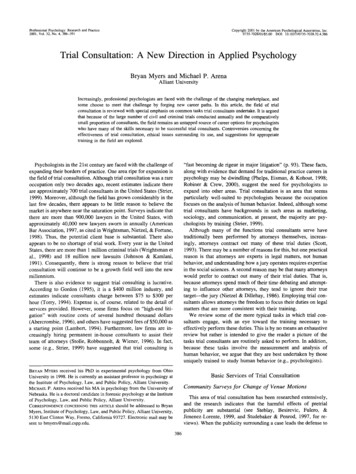
Transcription
Professional Psychology: Research and Practice2001, Vol. 32, No. 4, 386-391Copyright 2001 by the American Psychological Association, Inc.0735-7028/01/S5.00 DO!: 10.1037//0735-7028.32.4.386Trial Consultation: A New Direction in Applied PsychologyBryan Myers and Michael P. ArenaAlliant UniversityIncreasingly, professional psychologists are faced with the challenge of the changing marketplace, andsome choose to meet that challenge by forging new career paths. In this article, the field of trialconsultation is reviewed with special emphasis on common tasks trial consultants undertake. It is arguedthat because of the large number of civil and criminal trials conducted annually and the comparativelysmall proportion of consultants, the field remains an untapped source of career options for psychologistswho have many of the skills necessary to be successful trial consultants. Controversies concerning theeffectiveness of trial consultation, ethical issues surrounding its use, and suggestions for appropriatetraining in the field are explored.Psychologists in the 21st century are faced with the challenge ofexpanding their borders of practice. One area ripe for expansion isthe field of trial consultation. Although trial consultation was a rareoccupation only two decades ago, recent estimates indicate thereare approximately 700 trial consultants in the United States (Strier,1999). Moreover, although the field has grown considerably in thelast few decades, there appears to be little reason to believe themarket is anywhere near the saturation point. Surveys indicate thatthere are more than 900,000 lawyers in the United States, withapproximately 40,000 new lawyers sworn in annually (AmericanBar Association, 1997, as cited in Wrightsman, Nietzel, & Fortune,1998). Thus, the potential client base is substantial. There alsoappears to be no shortage of trial work. Every year in the UnitedStates, there are more than 1 million criminal trials (Wrightsman etal., 1998) and 18 million new lawsuits (Johnson & Kamlani,1991). Consequently, there is strong reason to believe that trialconsultation will continue to be a growth field well into the newmillennium.There is also evidence to suggest trial consulting is lucrative.According to Gordon (1995), it is a 400 million industry, andestimates indicate consultants charge between 75 to 300 perhour (Torry, 1994). Expense is, of course, related to the detail ofservices provided. However, some firms focus on "high-end litigation" with routine costs of several hundred thousand dollars(Abercrombie, 1996), and others have suggested fees of 50,000 asa starting point (Lambert, 1994). Furthermore, law firms are increasingly hiring permanent in-house consultants to assist theirteam of attorneys (Stolle, Robbennolt, & Wiener, 1996). In fact,some (e.g., Strier, 1999) have suggested that trial consulting is"fast becoming de rigeur in major litigation" (p. 93). These facts,along with evidence that demand for traditional practice careers inpsychology may be dwindling (Phelps, Eisman, & Kohout, 1998;Robiner & Crew, 2000), suggest the need for psychologists toexpand into other areas. Trial consultation is an area that seemsparticularly well-suited to psychologists because the occupationfocuses on the analysis of human behavior. Indeed, although sometrial consultants have backgrounds in such areas as marketing,sociology, and communication, at present, the majority are psychologists by training (Strier, 1999).Although many of the functions trial consultants serve havetraditionally been performed by attorneys themselves, increasingly, attorneys contract out many of these trial duties (Scott,1993). There may be a number of reasons for this, but one practicalreason is that attorneys are experts in legal matters, not humanbehavior, and understanding how a jury operates requires expertisein the social sciences. A second reason may be that many attorneyswould prefer to contract out many of their trial duties. That is,because attorneys spend much of their time debating and attempting to influence other attorneys, they tend to ignore their truetarget—the jury (Nietzel & Dillehay, 1986). Employing trial consultants allows attorneys the freedom to focus their duties on legalmatters that are more consistent with their training.We review some of the more typical tasks in which trial consultants engage, with an eye toward the training necessary toeffectively perform these duties. This is by no means an exhaustivereview but rather is intended to give the reader a picture of thetasks trial consultants are routinely asked to perform. In addition,because these tasks involve the measurement and analysis ofhuman behavior, we argue that they are best undertaken by thoseuniquely trained to study human behavior (e.g., psychologists).BRYAN MYERS received his PhD in experimental psychology from OhioUniversity in 1998. He is currently an assistant professor in psychology atthe Institute of Psychology, Law, and Public Policy, Alliant University.MICHAEL P. ARENA received his MA in psychology from the University ofNebraska. He is a doctoral candidate in forensic psychology at the Instituteof Psychology, Law, and Public Policy, Alliant University.CORRESPONDENCE CONCERNING THIS ARTICLE should be addressed to BryanMyers, Institute of Psychology, Law, and Public Policy, Alliant University,5130 East Clinton Way, Fresno, California 93727. Electronic mail may besent to bmyers@mail.cspp.edu.Basic Services of Trial ConsultationCommunity Surveys for Change of Venue MotionsThis area of trial consultation has been researched extensively,and the research indicates that the harmful effects of pretrialpublicity are substantial (see Steblay, Besirevic, Fulero, &Jimenez-Lorente, 1999, and Studebaker & Penrod, 1997, for reviews). When the publicity surrounding a case leads the defense to386
TRIAL CONSULTATIONquestion whether an impartial jury may be difficult to obtain,consultants may be asked to help attorneys prepare a motion for achange of venue.The consultant may begin by collecting evidence of negativepretrial publicity and producing a brief (e.g., approximately 20 minin length) questionnaire in which to query respondents. Dependingon the jurisdiction, voter registration or driver's license registrationlists are obtained to establish the pool of eligible jurors. A sampleof approximately 400 respondents (e.g., Bennett & Hirschorn,1993; Nietzel & Dillehay, 1986; Wrightsman, 2001) are theninterviewed, either by telephone, mail, or in person. Although lesscommon, a separate sample may be contacted from another countyin that state to compare the level of publicity and level of defendant prejudgment. If it can be shown that (a) a high proportion ofindividuals in the county in which the trial is scheduled is familiarwith the case and the publicity surrounding it, (b) those familiarwith the publicity are more likely to believe the defendant is guiltythan those not familiar with the case, and (c) those in the neighboring county are significantly less likely to have been exposed tothe negative publicity and therefore exhibit lower likelihood ofprejudgment, a strong case can be made for the need for a changeof venue.Some (e.g., Pollock, 1977) have suggested that change of venuemotions are rarely successful, citing methodological limitations ofthe surveys as a major cause. However, because a research literature now exists that focuses on improving the methods by whichchange of venue surveys are conducted (e.g., Leach, Arbuthnot, &Myers, 1998; Lennox, 1990; Moran & Cutler, 1991), consultantswho use these methods may be more successful than has previously been the case. Nevertheless, methodological limitations ofthe surveys are not the sole obstacle consultants must face becausemany change of venue motions are likely to be unsuccessful forreasons related to the financial and political costs of moving thetrial (Wrightsman et al, 1998).Because the success of the change of venue motion will berelated, to some extent, to the methodological quality of thesurvey, a strong background in methodological design and statistical analysis is critical. This type of training is not typicallyencountered in law school, but it is a basic component in graduatepsychology programs. In addition, the trial consultant who isfamiliar with the relationship between attitudes and behavior, aswell as basic memory processes, is better able to carry out researchthat can best identify and articulate the dangers of pretrial publicity. Those wishing to become familiar with the research on thedamaging effects of pretrial publicity, along with information morespecific to the construction of change of venue surveys, may alsoconsult excellent guides in this area (e.g., Krauss & Bonora, 1979;Nietzel & Dillehay, 1986).Jury SelectionThis role is most commonly associated with trial consultants—arole some find objectionable. Objections to jury selection techniques are no doubt related to the belief that these methodsthreaten constitutionally protected rights to trial by a fair andimpartial jury. However, the notion of an impartial jury is likelymore a myth than a reality (Kaplan, 1982), and proponents ofscientific jury selection are likely to believe in the adversarial387nature of trials (Nietzel & Dillehay, 1986). For example, one trialmanual provides the following instruction:you want a jury that will be open-minded, receptive to your proof,favorably disposed to you and your party, and ultimately will return afavorable verdict. Your opponent, of course, while also looking for ajury with an open mind, is also looking for a jury that will reactfavorably to her, her client, and her case. (Mauet, 1992, p. 23)From this latter perspective, juror bias may be considered the normrather than the exception, and the trial process is assumed to impartjustice as long as both sides have adequate opportunity to identifyand deselect those jurors who are likely to be unsympathetic totheir case.The use of social science methods to select jurors (i.e., scientificjury selection) can be traced back to the early 1970s and the trialof the "Harrisburg Seven" (Hans & Vidmar, 1982; Strier, 1999;Wrightsman, 2001). In this case, seven defendants were chargedwith conspiracy to raid draft boards and kidnap Secretary of StateHenry Kissinger. The defense team hired sociologist Jay Schulman, who used an extensive community survey and developedprofiles of desirable and undesirable jurors based on the results ofthis survey. The trial ended in a hung jury and sparked theincreased use of social science methods in litigation in otherhigh-profile cases such as the Wounded Knee trial and the trial ofJoan Little (Hans & Vidmar, 1982).The methods by which "scientific" jury selection are achievedare highly varied. Among the mainstream methods are interviewsand surveys for community and case analysis and construction offocus groups and mock trials.1 Less typical and more controversialare the reading of nonverbal cues (e.g., body language and facialexpression analysis) and the investigation of prospective jurors byinterviewing their friends and associates (i.e., questioning keyinformants). These latter two methods are not covered here because opinion is so heavily divided among experts along issues ofboth efficacy and ethics. The use of key informants may be toovulnerable to charges of jury tampering to be worth advocating,and although the use of nonverbal cues may be seen as credible bythose in the legal profession, a closer examination of the researchin this area suggests these methods may be of little use in thecourtroom. Nietzel and Dillehay (1986) noted that the research onassessing nonverbal cues and detecting deception relies on highlycontrolled settings that place few limits on the opportunity toeffectively view the participants (e.g., DePaulo, 1992; Ekman,1985). This is not the case in courtroom settings where distance,time, and field of vision all conspire against the accuracy of theconsultant who engages in nonverbal cue analysis. In addition,detecting deception through nonverbal cues is a difficult skill inthe best of circumstances, which few achieve, even after years of1Both mock trials and focus groups involve extensive questioning ofsmall samples of individuals representative of the jury venire. Mock trialsare typically more extensive (and expensive) in that they may include moredetailed aspects of the trial (e.g., testimonies by various mock witnesses,opening and closing statements, and group deliberation) than do focusgroups. Neither focus groups nor mock trials should be confused withshadow juries. Shadow juries involve a sample of participants witnessingthe actual trial and reporting their feelings and reactions to the evidence asthe trial progresses.
388MYERS AND ARENAexperience (Ekman & O'Sullivan, 1991). Thus, we limit our discussion to more routinely advocated jury selection tools.These more routinely advocated tools are used to present caseevidence to samples who are representative of the jury venire, tomeasure their reactions to the evidence, and to develop a profile ofthe ideal or acceptable juror and the dangerous or unacceptablejuror (Mauet, 1992). This method presumes that individuals whoare similar along a number of demographic characteristics (e.g.,race, educational background, socioeconomic status, age), as wellas attitudes regarding case-relevant issues (e.g., crime problems,police power, due process, tort reform), will be similar in theirverdict tendencies (Loh, 1984). The consultant uses a regressionapproach that consists of complicated weighting systems to identify the factors that best predict verdict tendencies on the basis ofthese methods (Suggs & Sales, 1978). Once the important factorsare identified, profiles are developed of the ideal and less thanideal juror on the basis of demographic and attitudinal characteristics. Prospective jurors are then compared with these profiles andassigned numerical scores based on how favorably their demographics and attitudes match the profiles (Suggs & Sales, 1978). Thisinformation can then be used by the attorney during the voir dire.Research on the effectiveness of scientific jury selection ismixed. Horowitz (1980) tested the effectiveness of scientific juryselection. Here, conventional methods by attorneys were comparedwith the use of social science methods for four trials. Neithermethod was found to be superior. In a series of studies addressingdemographics such as age (Hepburn, 1980; Mills & Bohannon,1980), race (Bernard, 1979), and gender (e.g., Hastie, Penrod, &Pennington, 1983; Mills & Bohannon, 1980; Moran & Comfort,1982), all were found to be significantly related to verdicts. However, a series of studies have found no relationship between manyof these same measures (Hepburn, 1980; Penrod, 1990; Saks,1976). Overall, demographic and attitudinal factors account forlittle variability in verdicts—between 5% and 15% (Hans & Vidmar, 1982; Hepburn, 1980)—which is small compared with theinfluence of evidence on verdicts (Visher, 1987).Although these relationships appear to be rather modest, it isimportant to note that even small differences can have appreciableeffects on a trial outcome and that the effects of scientific juryselection are greater when the evidence presented at trial is equivocal (Moran, 1990). Perhaps the best evidence for the effectivenessof social science methods is that they are systematic and that theyare based on the notion that specific attitudes may be related tospecific behaviors, a relationship that has been well-documentedelsewhere (Fazio, 1986). In contrast, attorneys tend to rely onstereotypes based on various trial strategy manuals, advice fromother attorneys, and their own experiences. According to Olczak,Kaplan, and Penrod (1991), "written accounts of attorney theoriesof the 'preferred' and 'nonpreferred' juror appear to be laced witheveryday stereotypes" (p. 432). These stereotypes are sometimestermed implicit personality theories—preconceptions about howcertain traits are related to one another (Schneider, 1973). Forexample, Olczak et al. (1991) found that attorneys tend to payparticular attention to juror occupation when selecting jurors(Fulero & Penrod, 1990). Often these stereotypes are perpetuatedin trial manuals (Fulero & Penrod, 1990; Ruben, 1995). Yet, themethods have not been empirically demonstrated to be effective,nor do they reflect highly complex criteria. In fact, Olczak et al.(1991) found that when juror selection was compared betweenattorneys and college sophomores, "attorneys did not use differentbases, nor show greater complexity in their reasoning [than collegesophomores]" (p. 442).Indeed, the application of social science methods in assessingjuror beliefs has been extensively examined. For example, scalesused to uncover pretrial biases have been shown to reliably predictverdicts (e.g., Kassin & Wrightsman, 1983; Kravitz, Cutler, &Brock, 1993; Myers & Lecci, 1998). Furthermore, an extensiveresearch literature exists on a variety of issues and their relation tojuror judgments, such as the characteristics of the defendant andvictim (e.g., Dane & Wrightsman, 1982) as well as how jurorcharacteristics such as authoritarianism (e.g., Kaplan & Miller,1978), sociomoral reasoning (e.g., Arbuthnot, 1986), need forcognition (e.g., Kassin, Reddy, & Tulloch, 1990), race (e.g.,Pfeiffer, 1990), and gender (e.g., Brigham & Wasserman, 1999)can interact with the evidence in ways that may influence judgments. Fulero & Penrod (1990) argued that the true test of theeffectiveness of social science methods is whether or not thesemethods exceed the effectiveness of techniques used presently byattorneys. Because these issues have been empirically tested, consultants who use these methods can inform attorneys of theirdocumented effectiveness. This alone, we argue, is a significantreason behind relying on social science methods over the armchairtheorizing and largely anecdotal findings presented in trialmanuals.Trial Strategy TestingThis task relies heavily on consultants using community samples either in the form of focus groups, mock trials, or communitysurveys to provide attorneys with feedback regarding how theirplanned trial strategies are likely to be accepted by jurors (Nietzel& Dillehay, 1986; Wrightsman, 2001). Although attorneys maytypically rely on experience to predict juror reaction to evidence,measuring the reactions of representative samples, prior to trial,may be more effective. Those experienced with the trial processunderstand that attorneys routinely establish a strategy before thetrial and that strategy chosen can have an appreciable impact onthe trial outcome (Krauss & Bonora, 1979). Thus, trial strategiesmay involve deciding what evidence may be most damaging (ormost easily challenged) and preparing methods designed to discredit, challenge, or minimize their impact. Trial consultants canaid this process by working with samples of jury-eligible adultsthrough the use of focus groups, mock trials, or surveys (Scott, 1993;Wrightsman, 2001). Participants provide feedback to consultantsabout what trial facts most influenced their decisions and why. Consultants can then present this information to attorneys so that they maybegin to develop strategies to counter this evidence. The effectivenessof these counterstrategies can then be tested on a new sample.Further refinements are possible, including the shaping andordering of testimonies in ways that are likely to conform to bothjuror schemas and to primacy and recency effects. For example,research suggests that individuals routinely interpret incominginformation according to existing schemas (Fiske & Taylor, 1991;Moore, 1989). Along these lines, when processing trial information, jurors attempt to create a "story" of what happened (Pennington & Hastie, 1986) and evaluate the probative value of each pieceof evidence according to how well it fits the existing story (Moore,1989). By identifying the story or "theme" (e.g., Mauet, 1992; also
389TRIAL CONSULTATION"case theory"; Krauss & Bonora, 1979) that will be represented inthe case, attorneys can use trial consultants to test jurors' reactionsto these themes. The consultant will use surveys, focus groups, andtrial simulations to determine whether each testimony is consistentwith the case theme. Thus, if we may regard trial testimony as themanner in which a story is told to the jury, the trial consultant helpsarrange the testimonies in a way that does not alter the evidence,but rather, presents the testimonies in a manner that best facilitatesjuror comprehension.The ideal background for competence in this area is a substantialfamiliarity with issues related to decision making, social psychological research on attribution theory, and research on memory andcognition. Again, extensive use of trial simulations and surveysrequires some sophistication in the area of data analysis andresearch design. We maintain that although attorneys may chooseto study these areas so that they become familiar with the researchand perform these functions without the aid of a trial consultant,competency in these areas requires training most consistent with agraduate degree in psychology.Witness PreparationWitness preparation is just one element in a vast array ofpostselection tools provided by consultants (see Strier, 1999, for areview). Witness preparation involves efforts to improve witnesscommunication skills. It is important to note that the role of theconsultant is not to change the evidence provided by the witnessbut to modify the manner in which the evidence is conveyed to theaudience. As a popular manual in witness preparation suggests,"preparation enhances the witness' ability to speak clearly andhonestly so that the story unfolds in a way that is understandableto the jury" (Krauss & Bonora, 1979, p. 15).To better assist this process, the consultant may evaluate thewitness beforehand to determine how he or she should best bequestioned by the attorney. Depending on the capacity for thewitness to communicate effectively, the consultant may suggestthe attorney use either a fragmented style of questioning (brief witnessresponses) or a narrative style of questioning (extensive witnessresponses). Research suggests that style of questioning is related toperceptions of witness competence, trustworthiness, and intelligence(Lind, Erickson, Conley, & O'Barr, 1978; Roberts, 1987).Furthermore, there are a host of factors consultants may consider to aid the testimony and further the case for their client, suchas the order of witness presentation, the need to disclose negativeinformation about a client to the jury before the other side does(i.e., "stealing thunder"), and reducing witness anxiety. Regarding thelatter issue, some have argued that witness stress is one of the chiefundermining factors in witness credibility (Roberts, 1987). Witnessesmay appear terse, arrogant, or even deceptive and untrustworthy as aresult of the stress associated with testifying in court.Another element of effective witness presentation is the analysisof powerful versus powerless speech. Consultants can examine thetestimony of witnesses and look for factors known to decreasepersuasiveness in a trial context: (a) excessive use of hedging (e.g.," I think"), (b) overuse of intensifies, (c) hypercorrect speech (i.e.,using advanced vocabulary or excessive use of jargon), and (d) useof a questioning intonation with declarative statements. Thesetendencies limit the ability of the witness to persuade the audience,and trial consultants can work to make witnesses aware of thesetendencies (Erickson, Lind, Johnson, & O'Barr, 1978).Comprehension of the message is another key to effectivetestimony, and researchers warn that jurors understand far less ofwhat they are told during a trial than attorneys assume (English &Sales, 1997). As Krauss and Bonora (1979) noted, trial consultantscan be especially useful in evaluating witness testimony becausethey are less familiar with the case than is the attorney, and theyare therefore better able to identify aspects of the testimony thatare missing or confusing. In addition, some trials may be particularly complex. Expert witnesses are often required to testifyconcerning facts that may be difficult for jurors to comprehend(Nietzel & Dillehay, 1986). Consultants can estimate the likelihood of juror confusion by presenting videotapes of mock testimony by the witness to jury-eligible adults and can measure thedegree to which participants understand the testimony. With thisfeedback, attorneys can ask appropriate follow-up questions so theexpert can increase juror comprehension.Familiarity with the social psychological literature regardingpersuasion is necessary to be successful in this area of trial consultation. The trial consultant with advanced training in socialpsychology is likely to be familiar with (a) research relevant tocommunicator credibility (e.g., Hovland, Janis, & Kelley, 1953;Zimbardo & Leippe, 1991), (b) the relationship between the audience and the message (e.g., Chaiken, 1980; Petty & Cacioppo,1986), (c) factors related to audience resistance and openness topersuasion (e.g., McGuire, 1964; Sherif, Kelly, Rodgers, Sarup, &Tittler, 1973), and (d) the relationships between values, attitudes,and judgments (e.g., Ajzen & Fishbein, 1980). This level oftraining is typical of graduate-level courses in social psychology orsocial cognition.Professional IssuesAlthough trial consultation has been identified as an emergingfield with significant growth potential, it has not gone withoutsome criticism (Nietzel & Dillehay, 1986; Strier, 1999). Thesecriticisms have largely concerned the fear that the practice of trialconsultation serves to threaten our system of justice and the beliefthat the field is poorly regulated and therefore open to wellintentioned incompetents or deliberate fakery.Some have argued that the first belief is most strongly felt bythose less comfortable with the justice systems (i.e., criminal andcivil) operating in an adversarial fashion. As Stolle et al. (1996)indicated, journalists tend to believe that "the use of a trial consultant can provide a litigant with an advantage, only large corporations and wealthy individuals will have access to this high-pricedadvantage, leaving the average litigant with some form of secondclass justice" (p. 147). Although it may be true that effectiveconsultation may place one side of a dispute at an advantage, thismay also be true of virtually every other participant in the trialprocess. That is, attorneys, witnesses, experts, and judges all differfrom case to case and allow for variations in the "justice" associated with a judgment.In addition, critics may be unaware of the various factors thatserve to unbalance the scales of justice and therefore are less likelyto see a trial consultants' efforts as work to restore the balance. Forexample, those who routinely study jurors are all too aware of theprevalent belief by jurors that most defendants charged withcrimes are probably guilty (Kassin & Wrightsman, 1983; Myers &Lecci, 1998) and that a significant proportion of jurors hold misconceptions such as the belief that it is the duty of the defendant to
390MYERS AND ARENAprove his or her innocence. Critics may also be unaware of thebiases present that serve to undermine impartiality in civil cases,such as negative attitudes toward corporations (i.e., plaintiff bias;Hulbert, Parks, Chen, Nam, & Davis, 1999) and "deep pockets"attitudes (Hans & Lofquist, 1992; Vidmar, 1993). Given the plethora of factors that threaten the reality of the fair and impartial jury,one wonders whether the perceived injustice associated with trialconsultation is more a function of the fear that outsiders (e.g.,psychologists) may soon invade a domain that was exclusivelyhandled by attorneys.Regarding the second belief, the field indeed is largely unregulated, which allows greater possibility for poorly trained practitioners or charlatanism. Although we have outlined some basicfoundational training that would prepare individuals for this line ofwork, this is by no means sufficient. That is, although psychologists may have greater preparation to work in the area of trialconsultation than would attorneys (who have little training in theanalysis of human behavior), standard training in most graduateprograms in psychology is not sufficient to prepare individuals toenter the field of trial consultation. Individuals interested in obtaining more advanced training may attend conferences offeredthrough the American Society of Trial Consultants as well as theAmerican Psychology-Law Society (APA division 41).2 In addition, interested readers may want to consult some excellent guidesto trial consultation (e.g., Abbott & Batt, 1999; Krauss & Bonora,1979) as well as subscribe to Law and Human Behavior, a journalthat frequently publishes research on jury decision making.For the field to advance, we argue that standards in both trainingand methods need to be established. The development of some ofthese standards (i.e., survey methodology) are currently in theprocess of taking place (American Society of Trial Consultants,1998). Standards in training will likely increase the efficacy of trialconsultation, although measuring success is difficult because thepresence of a consultant will normally covary with the experienceand economic resources of the attorney. Nevertheless, standards intraining allow for practitioners to be educated about issues theymight not normally encounter in standard graduate programs inpsychology (e.g., ethical issues that are unique to trial consultation). Nietzel & Dillehay (1986) cited such ethical concerns asaccepting fees on a contingency basis, assuming dual roles such astestifying as an expert in cases in which one also works as aconsultant for one side, exaggerating claims of competence toprospective clients, and e
University in 1998. He is currently an assistant professor in psychology at the Institute of Psychology, Law, and Public Policy, Alliant University. MICHAEL P. ARENA received his MA in psychology from the University of Nebraska. He is a doctoral candidate in forensic psychology at the Institute of Psychology, Law, and Public Policy, Alliant .
